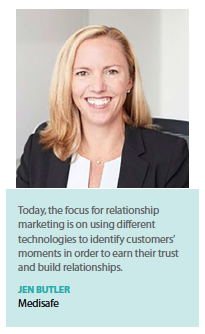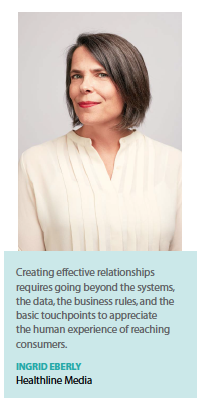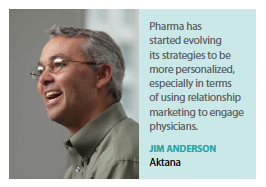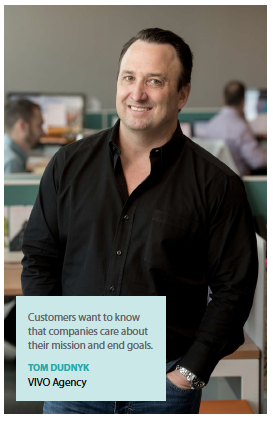Relationship marketing has evolved to include the entire spectrum of the healthcare journey.
Relationship marketing used to mean developing a relationship between a sales rep and a physician, but today it represents so much more. From fostering relationships between patients, HCPs, industry, and advocacy organizations to  cultivating a level of compassion and understanding that results in relationships with patients and patient communities, today a relationship marketing strategy has evolved into an approach that engages patients and physicians and other stakeholders from the very beginning of any healthcare journey to the end.
cultivating a level of compassion and understanding that results in relationships with patients and patient communities, today a relationship marketing strategy has evolved into an approach that engages patients and physicians and other stakeholders from the very beginning of any healthcare journey to the end.
Experts suggest that as the strategy continues to evolve to encompass so many more opportunities provided by digital and technical advances, relationship marketing may be a bit of a misnomer. The name for the strategies should also evolve to something more like community marketing or omni-channel planning, for example.
“We often talk about changing the name of these efforts to something more inclusive such as omni-channel planning because of how all the touchpoints have come together," says Sarah Espinal, director of strategic planning and insights at Cambridge Biomarketing. “Gone are the days of silos for each touchpoint.
“Today marketing is so integrated," she continues. “I love the term community marketing or something to that effect, because it connotes something deeper. It’s about putting together all of the data that we have available to us and understanding how people are behaving. This is a benefit for marketers, but also a responsibility — a responsibility to be responsive and provide better personalized experiences for everyone."
What Ms. Espinal means is that relationship marketing is not about just  knowing what the patient or physician needs right now, but what he or she will need and want all along the experience, however long that might be.
knowing what the patient or physician needs right now, but what he or she will need and want all along the experience, however long that might be.
By using tools and technology such as predictive analysis, tracking activities, AI and consumer feedback, relationship marketing — or CRM or PRM or whatever it’s called — becomes a brand’s road map to a multifaceted emotional connection with all of its consumers, which hopefully leads to retention and loyalty. Relationship marketing refers to all of the varying elements necessary to facilitate such relationships.
Customer relationship management and partner relationship management have different functions within the overall relationship strategy, but they are only part of the total system. These two approaches use data-driven analytics from data that have already occurred, enabling only a rearward facing solution. Looking forward is imperative to effective relationship building.
“People, especially people who use digital tools, change their behaviors daily," says Ingrid Eberly, VP, corporate marketing, Healthline Media. “It’s important to not get stuck using history to drive a PRM strategy. Instead, the strategy needs to evolve. Marketers need to think about where the customer is going, not where she may have been a year ago. My advice is to use technology platforms and data backbone to execute, and add the human touch and make bold moves."
“We talk to the VPs of brands about how they have to evolve their marketing approaches," says Jen Butler, chief marketing officer at Medisafe. “Relationship marketing has transformed into not just owning sales expectations, but also retaining customers through enhanced experiences. Those are the retained revenue streams that marketers need to go after in today’s world, especially with the competitiveness of the pharma industry.
“In today’s age, the focus is on the different technologies to gain the customer’s moments that matter to gain his or her trust and build that relationship," she adds. “I think in that vein, marketers have to be a little bit more savvy. Gone are the days of Mad Men where brand managers just put up the billboard and have influence; we have to influence patients in much more engaging ways and to incorporate these messages into our customers’ lives."
According to Jim Anderson, chief customer officer at Aktana, pharma companies have started evolving their strategies to be more personalized, especially in terms of using relationship marketing to engage physicians. Personalization is one of the most important elements for effective relationship marketing, and marketers need to understand that every touchpoint is an opportunity to build brand affinity.
“Marketers have historically segmented their audiences into different groups and sent nearly identical messaging to each member. Today they’re increasingly  shifting toward the individual physician level," Mr. Anderson says. “This transition is a critical element of effective relationship marketing, as it enables more personalized communications and deeper relationships."
shifting toward the individual physician level," Mr. Anderson says. “This transition is a critical element of effective relationship marketing, as it enables more personalized communications and deeper relationships."
Patient adherence is one of the many touchpoints where relationship marketing can be implemented. An end-to-end patient adherence solution, like the one in a recent strategic collaboration between Lash Group, a patient support services company, and Medisafe’s mobile application, provided real-time, personalized interventions using predictive analytics and machine learning. The collaboration created visibility into patients’ approval and shipment status of their medication, while simultaneously providing a digital connection for nurses to educate and engage with patients. The daily digital communication aims to improve adherence rates and instill healthy behaviors. Medisafe’s research shows that refill rates for its users are as much as 17% higher than for non-users.
“The partnership with Lash has really revolutionized our thinking around supporting a total patient journey," Ms. Butler says. “We now are integrating patients into the hub, supporting patients before the first prescription fill and creating a digital connection to their nurse coordinators. Before we worked with patients as they were coming on to medication. And now, we’re actually helping them throughout their journey."
Crucial Elements of Relationship Marketing
According to our experts, there are several elements that are crucial in today’s type of relationship building. One includes the advances in technology, especially the use of artificial intelligence (AI).
Marketers are increasingly using AI to inform the tactical plans they execute for each individual, spanning both personal and nonpersonal communication channels, specifically for physicians.
AI enables data-driven decisions to shape customer-specific strategies across every channel, including the sales representative, and significantly reduces the resources needed to build and refine a strategy following each and every interaction, Mr. Anderson says.
Optimization is another key to building an effective relationship strategy; this  means ensuring each interaction is informing the next step of the plan so the consumer has the best possible experience and the team is operating at its most efficient level.
means ensuring each interaction is informing the next step of the plan so the consumer has the best possible experience and the team is operating at its most efficient level.
“We need to constantly evaluate the impact of each given strategy to further drive personalization and refine plan elements such as channel integrations, pacing, or messaging sequence," Mr. Anderson says. “This results in better physician relationships and increased understanding of consumers’ preferences as well as significant increases in sales."
Creating effective relationships also requires going beyond the systems, the data, the business rules, and the basic touchpoints to appreciate the human experience of reaching consumers, Ms. Eberly says.
“Brands need to lean in," she says. “I mean, really lean in."
For one, leaning in constitutes knowing how the target audience intersects with the brand. “Not the product, but the brand," Ms. Eberly stresses. “It’s important to do this with emotion and empathy and a passion to drive a positive impact. This fire will keep the relationship alive and fuel it at every step of the way."
Leaning in also means listening earnestly to consumers. Ms. Eberly suggests using qualitative and quantitative feedback, studying consumer behaviors retroactively and prospectively, and run scenarios every day. This rigorous feedback process enables a full understanding of consumers’ mindsets and what motivates them and allows an alignment of strategy with their needs.
Knowing the consumer as a specific person is also particularly relevant to good relationship marketing, says Michael Leis, chief content strategy officer, Digitas Health and Publicis Health. For example, it is not enough to know the target audience is women between the ages of 35 and 44 — this is good information for media targeting, but it’s not specific enough to create a lasting relationship.
Marketers need to understand “who," specifically, at each stage of the funnel, and what action they need to take for each individual’s needs as they go through their journey. Knowing the type of content that women who are aged 35 to 44 years of age use to connect with other people, for example, can align stakeholders and agencies to the tone and assets they need at each step.
“Marketers need to be able to envision what they see a person doing as a result of receiving the message," Mr. Leis says. “They need to specify the actions people need to take and the assets they need to design for the intersection of their goal and the personal goal of the brand."
There is an epidemic of low value/high volume company content bombarding customers across all imaginable touchpoints. Instead of fostering stronger loyalty, it is having the opposite effect. It is turning customers away, according to Tom Dudnyk, president of VIVO Agency. “To fix it, you have to redefine what good looks like from the customer’s perspective, not yours."
Ms. Espinal suggests that the first step in determining a strategy is to identify who needs to be reached, understand what is known about them, determine the channels they use, and create content that is going to be most influential for them.
“This requires making sure the strategy is aligned on where we want to be, what we want to say, the desired behavior changes we’re looking for, and how we’re going to be adding value," she says.
“The strategy needs to be well mapped out upfront and documented in a  strategic framework, which allows us to make sure that in any decision we’re making, we’re checking back to that strategic document. This alignment adds value and helps us achieve the strategic direction."
strategic framework, which allows us to make sure that in any decision we’re making, we’re checking back to that strategic document. This alignment adds value and helps us achieve the strategic direction."
There also needs to be alignment within the organization from the ground up with an organizational commitment to the execution. And it’s not just a set it and forget it strategy, she says; everyone needs to keep learning and adapting for success. “We adapt our approach, evolve the content we’re providing, and make sure that we’re providing a personalized experience for those who we’re communicating with."
Social Media Enhances Relationship Building
Social media provides many opportunities to connect with consumers. Consumers can use social media to ask questions about brands, allowing the company to respond back with credible information that is helpful, thus establishing a relationship and trust. Listening to what customers have to say is a great way to identify concerns and further understand their motivation. These interactions can also build a better brand image.
One way to effectively use social media is by qualifying potential patients through engagement and retargeting, Mr. Leis says. “In the traditional system, we advertise a singular clinical message to a large target audience, then expect some percentage of those people to click through to a website that contains a survey that qualifies them as a patient," he says. “We have successfully taken the answers to those questions and distributed them as content assets in social media. This allows people to qualify themselves through engagement."
For one client, Digitas Health created a sequence of content on Facebook that first discusses what it’s like to have migraine headaches. People who engage with this content have qualified themselves as a migraneur, or the supporter of a migraneur. This is far more targeted than the initial media buy. Now, we can follow up with content that takes a clinically qualifying question, such as “How many migraine headaches have you experienced in the last 30 days?" and serve a lead-gen ad unit with content that is the answer. Anyone who has clicked to sign up for CRM has qualified themselves twice at this point. First for having migraines, and second for having a clinically qualifying frequency.
“The only people who click to sign up for CRM are people who have looked at that clinically qualifying asset and thought: ‘that’s me,’ " Mr. Leis says. “It’s a much better measure of qualification than the existing framework, which first asks if someone is capable of clicking from one site to another, and then through a survey, and short-cuts directs them by simply asking ‘Is this you?’ to give them the info they need, right where they need it."
In social media, content is key; it must be authentic and provide value to the patient or physician. Pharma can build a community around a particular topic if the content is additive and not distracting from the patient conversation. There  are a lot of disease conversations already occurring on social media, so the goal is to add value to the existing groups. Focusing on relationship building as opposed to persuading must be kept top of mind when engaging in social media interactions.
are a lot of disease conversations already occurring on social media, so the goal is to add value to the existing groups. Focusing on relationship building as opposed to persuading must be kept top of mind when engaging in social media interactions.
One of the biggest challenges in using social media, however, is identifying physicians outside of industry channels such as Doximity, WebMD, and other provider-specific venues. Having a sound strategy in place for how to use social media to locate and communicate with physicians will go a long way, Mr. Anderson says.
Mr. Anderson cites an interesting trend in China, which is gaining traction pertaining to communicating with patients on social media. As of 2017, more than 38,000 medical facilities in China were using one of the world’s largest messaging apps, WeChat and more than 1 million Chinese citizens had looked for or used healthcare services through the app.
“We’ve also seen many patient communities pop up on platforms such as Facebook, such as AbbVie’s psoriasisSPEAKS or Pfizer’s Breast Cancer: A Story Half Told, which help elevate the voice of the patient," he says.
In the rare disease space, social media is particularly important for creating connections for patients who are normally quite isolated or feel isolation due to their condition. It can be very expensive and difficult to find patients with rare diseases, so once a connection is made on social media, relationship marketing is a critical tool in fostering and developing those relationships, Ms. Espinal says.
There’s nothing like a well-executed relationship-marketing plan to really create that engagement opportunity, says Ms. Espinal. “It’s one of the best avenues from a value or ROI perspective."(PV)
~~~~~~~~~~~~~~~~~~~~~~~~~
Three Steps For Creating Effective Relationship Marketing Strategies
 Tom Dudnyk
Tom Dudnyk
VIVO Agency
1. Create content that is genuinely valuable to customers.
Turn your content strategy outside in. Customers want to know that companies care about their mission and end goals. Create content that proves this by educating customers on how best to achieve them. Make sure the content cannot be found anywhere else.
2. Make it short.
The second people see longer form content, they choose to not engage. The reason you see so much of it is because short form is more challenging to create. Build strong relationships by committing to short form content that is punchy, unexpected, simple to read, and entertaining.
3. Never violate Steps 1 & 2.
Companies are asking very busy customers for the one thing in shortest supply: their time. They give it based on the quality of their past experiences. When content quality wavers, customers switch their time elsewhere.


















